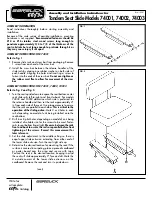
Configuring with Web Based Management
4.2 Starting the WBM
SINEMA Remote Connect - Server
Operating Instructions, 11/2017, C79000-G8976-C383-04
37
Entering the wrong user name or password
If you enter a user name that is not configured, an error message is displayed regardless of
the password entered. A user name or a variety of incorrect user names can be entered any
number of times without the system being locked.
Note
Loss of the administrator password
Note down a newly assigned or modified administrator password and keep this in a safe
place.
If only one administrator is set up, the loss of the administrator password means that no
more administrator tasks can be performed.
There is no possibility of resetting the assigned administrator password.
Note
Incorrect entry of the password
If you enter an incorrect password with the user name an error message is displayed.
If you enter an incorrect password, a lock out time begins that is extended with each attempt
to logon with an incorrect password.
4.2.2
Logon with the Smartcard / user certificates
Logging on with the smart card corresponds to a two-level security system.
The 1st level is possession of the card and the 2nd level is the personal identification
number (PIN) for unlocking the smart card. On the smart card there must be the PKI
certificate and the private key belonging to it.
As an alternative the PKI certificate can also be on the hard disk of the SINEMA RC client.
The private key is then, however, not protected by the Smartcard, but must be protected by a
different suitable measure, e.g. encryption of the private key, integrated measures in the
Web browser.
Chain of certificates to the root certificate
The certificates of a PKI are often organized hierarchically:
At the tip of the hierarchy are the root certificates. These are certificates that are not certified
by a higher-level certification authority. Certificate owner and certificate issuer of root
certificates are identical. Root certificates are fully trusted, they are the "anchor" of trust and
must therefore be known by the recipient as trustworthy certificates. They are stored in an
area intended for trustworthy certificates.
Depending on the PKI, the function of root certificates can be, for example, to sign
certificates of lower-level certification authorities, so called intermediate certificates. This
transfer the trust from the root certificate to the intermediate certificate. An intermediate
















































